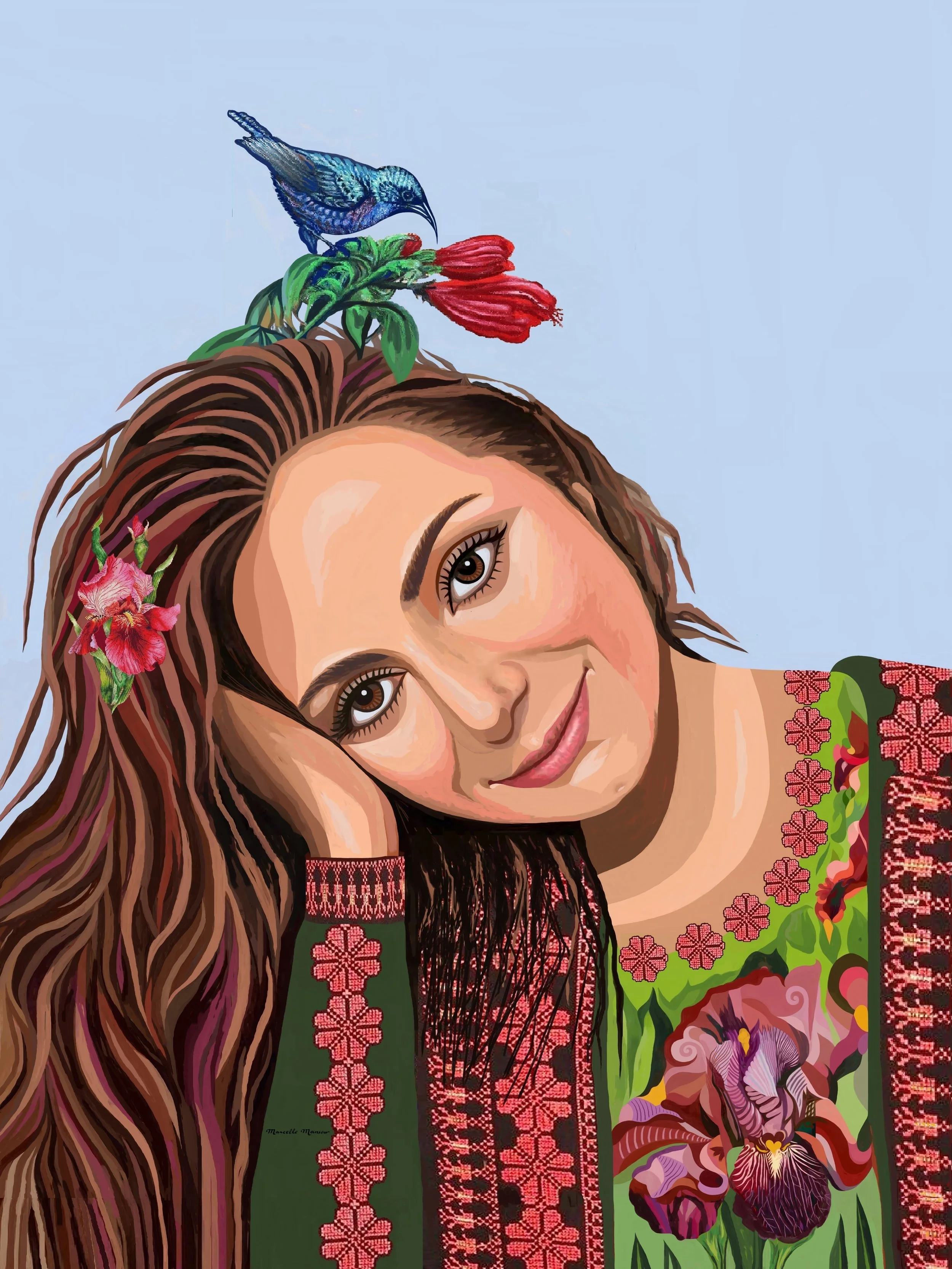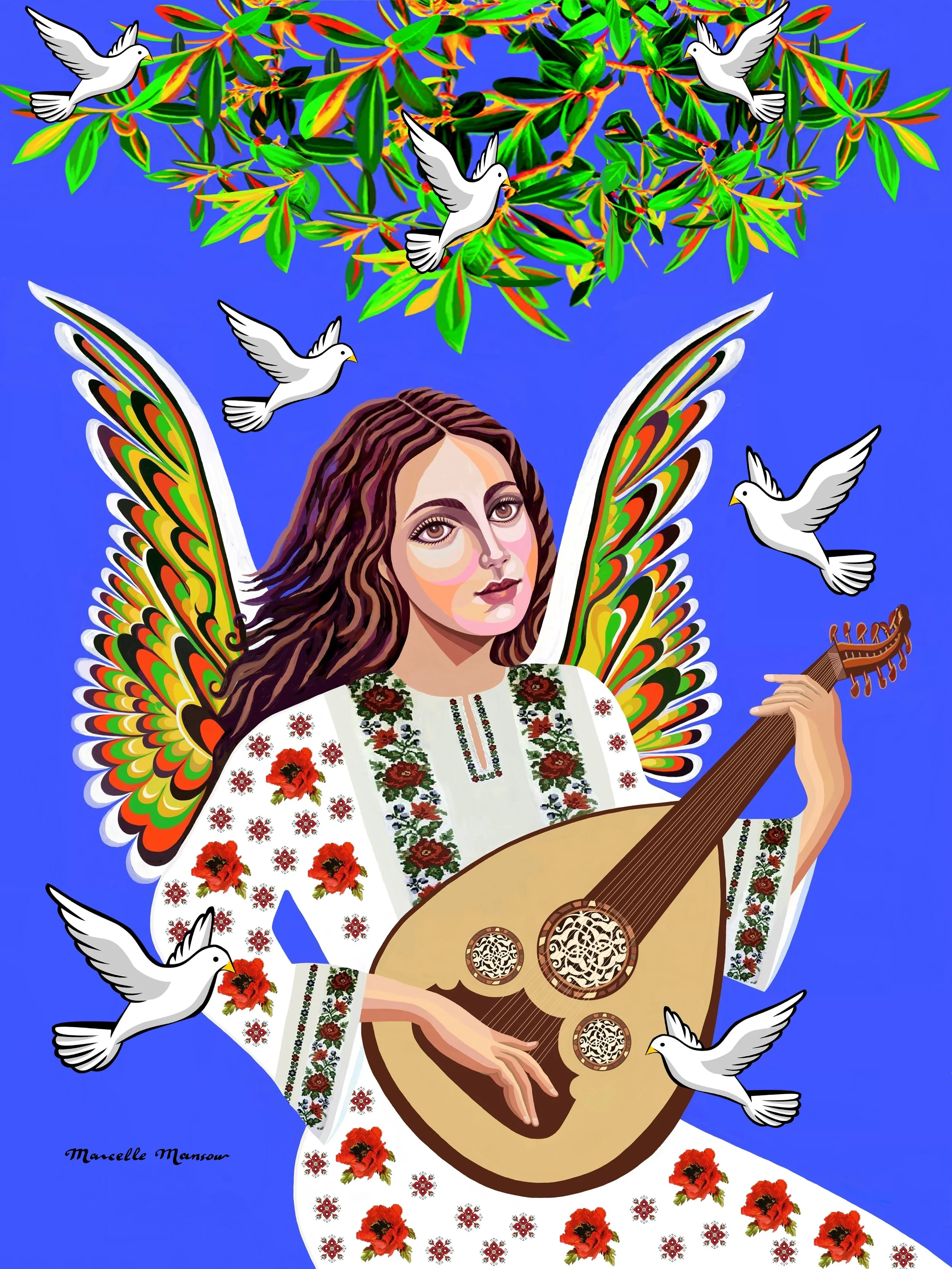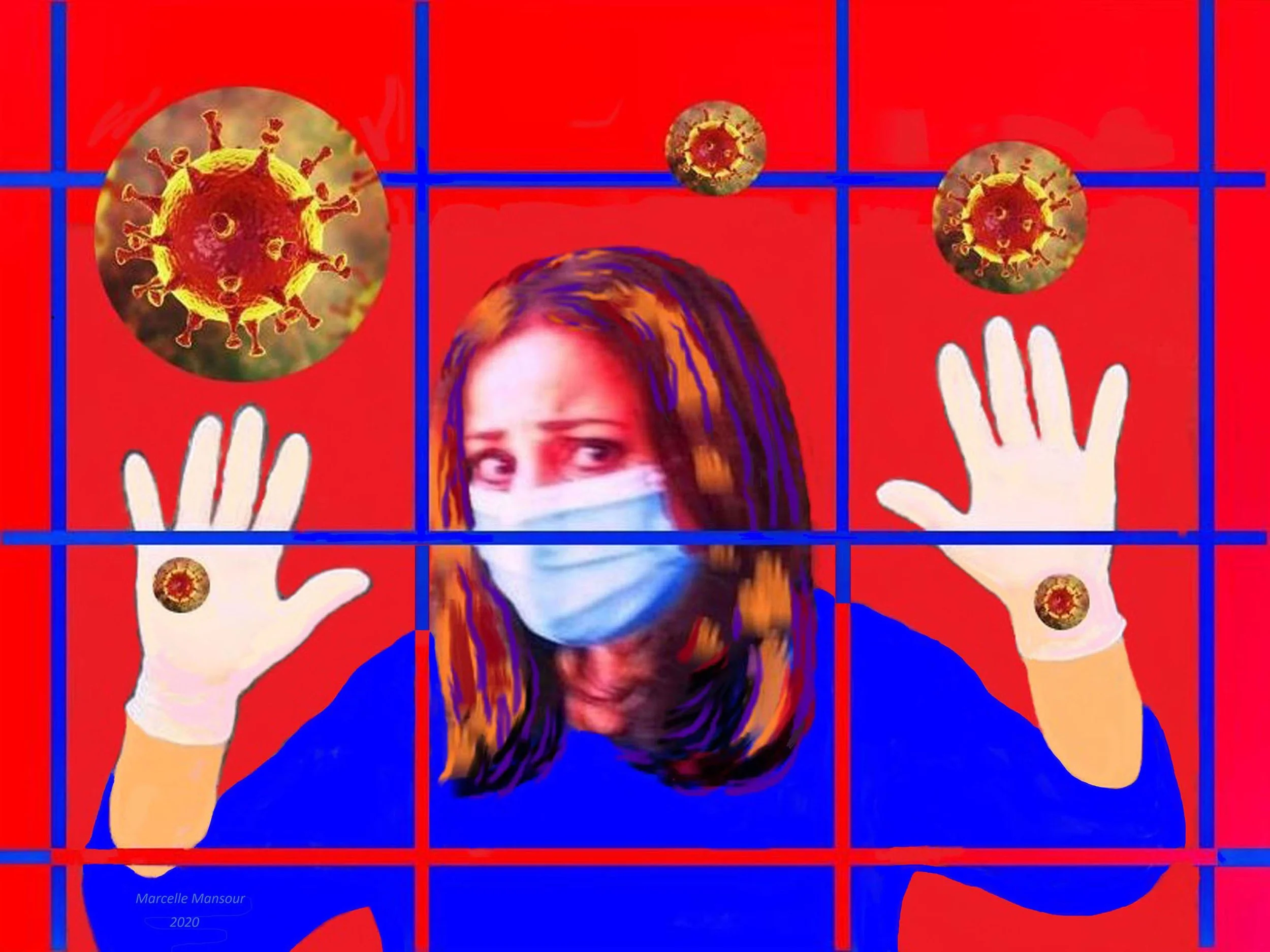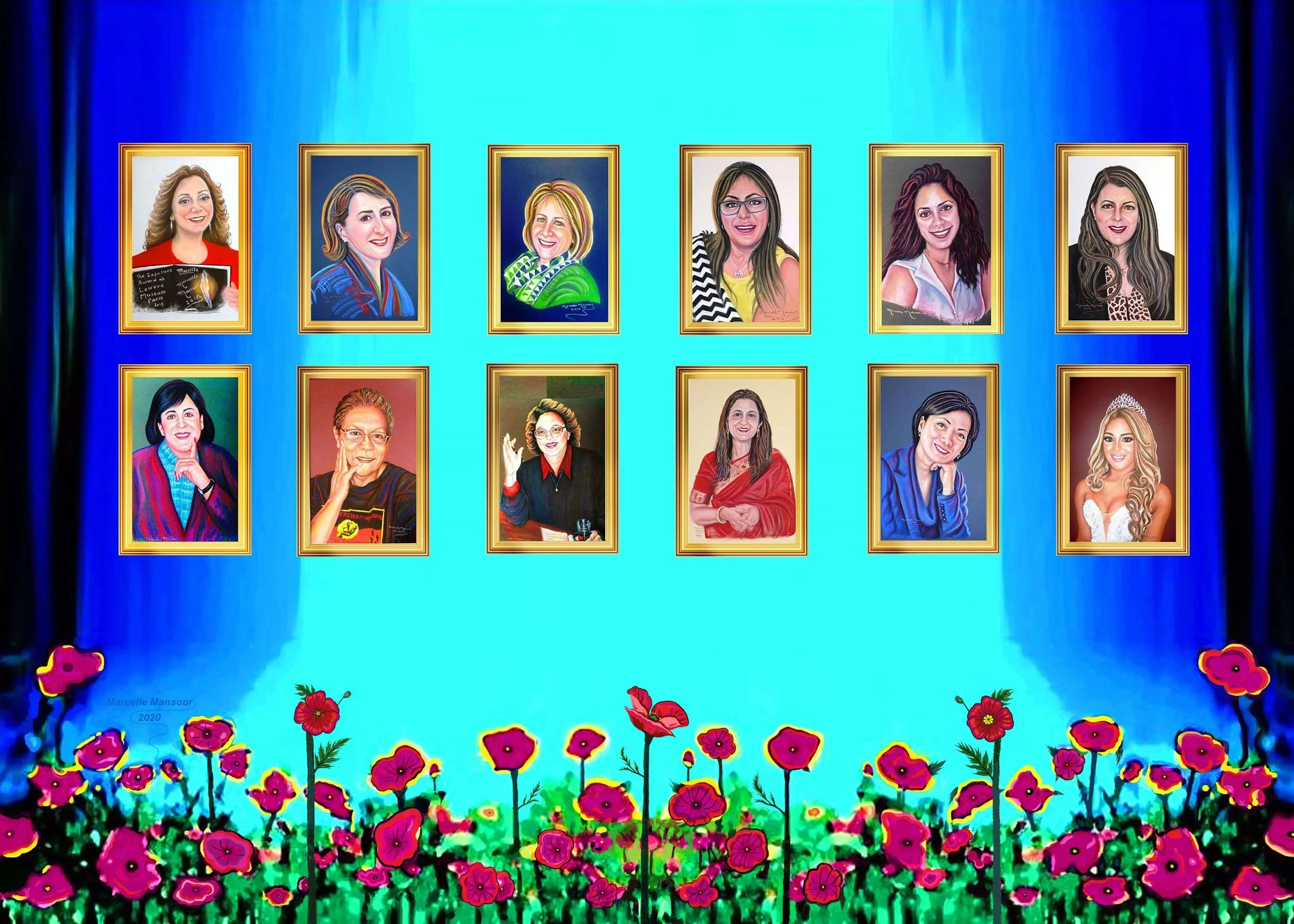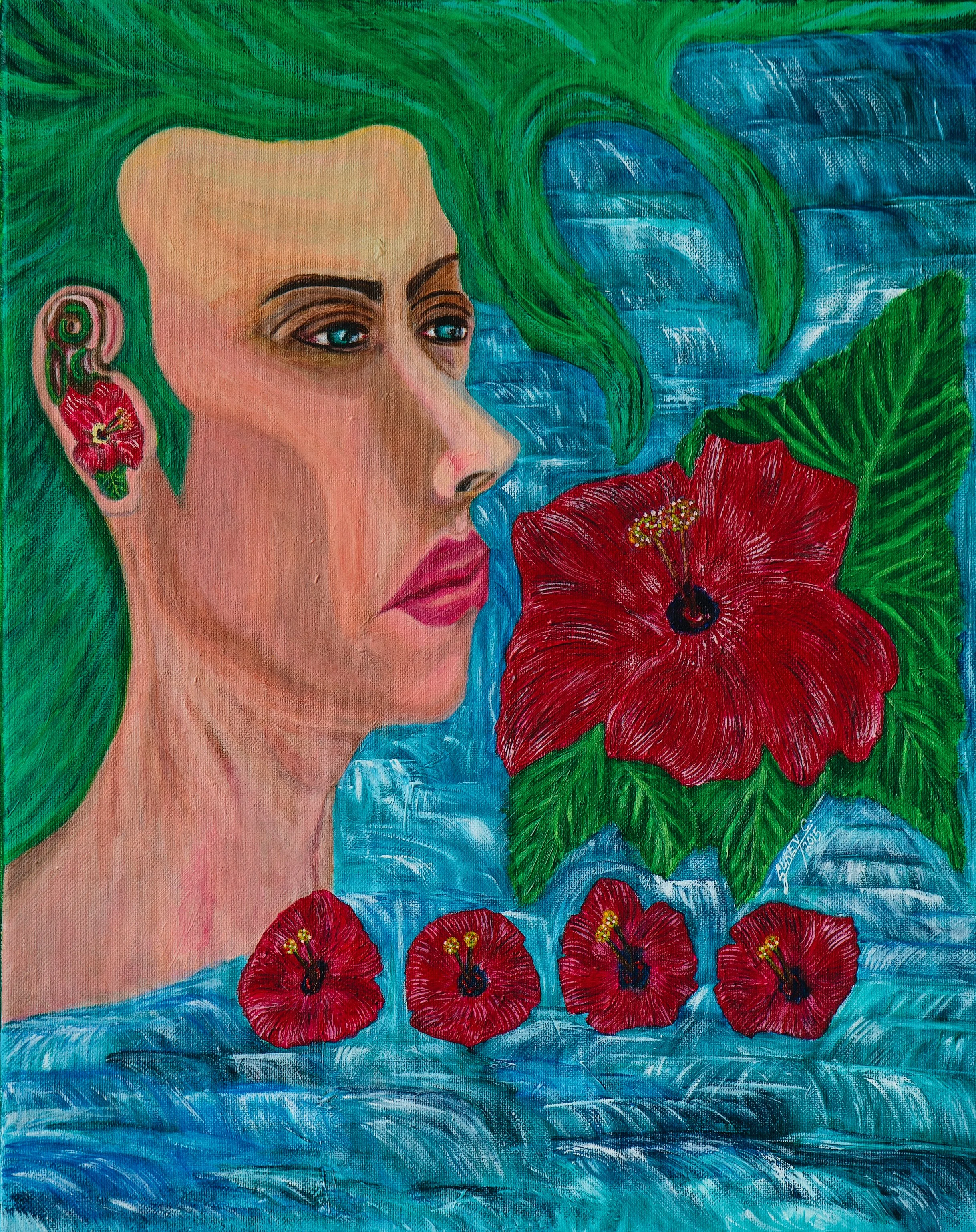Marcelle Mansour
https://marcellemansour.com.au/
To look at the art of Marcelle Mansour is to encounter a visual and philosophical language that exists between worlds, between tradition and technology, figuration and abstraction, spirit and matter, past and future. Mansour’s work, unfolding over decades of restless experimentation, is less a linear progression than a constellation of revelations. Her practice encompasses the tactile intimacy of portraiture, the transcendence of light painting, and the conceptual clarity of digital media. Across these shifting modalities, one thread remains unwavering: a profound belief in art’s power to heal, to illuminate, to awaken perception, and to restore the idea of humanity itself.
Mansour stands as a multidisciplinary visionary, a painter, poet, author, and Ambassador of Art and Peace, whose oeuvre transforms the language of color and light into a metaphysical inquiry. Her artistic philosophy echoes the radical spiritualism of Hilma af Klint, the early 20th-century pioneer who sought to translate the unseen into form. Like af Klint, Mansour employs abstraction not as aesthetic escape but as revelation: a means of articulating the invisible geometries of consciousness, faith, and transcendence. Yet, whereas af Klint looked upward toward theosophy, Mansour’s gaze is both celestial and humanist, anchored in empathy, memory, and the shared struggle for peace.
Her art thus resists categorization. It traverses the porous boundaries of medium and meaning, drawing from oil, acrylic, and pastel; from photography, digital manipulation, and the immateriality of light itself. This versatility is not mere virtuosity; it is a method of inquiry. Mansour moves between analog and digital, figuration and abstraction, control and serendipity, as if each polarity were a dialect of the same universal language. She has become, in essence, a cartographer of perception, mapping not the visible world but the luminous architectures of consciousness that underlie it.
In the early phases of Mansour’s artistic journey, her practice reflected a profound attachment to the tangible, the human face, the cultural landscape, the personal and collective memory of belonging. Her portraits of prominent Australians, celebrated in exhibitions such as Shifting Waves (1998) and Treasure Forever (2016), bear witness to a painter of extraordinary technical dexterity and psychological depth. These works belong to a lineage of portraiture that honors the sitter not merely as subject but as vessel of human experience. Yet, even in these traditional compositions, light was never secondary; it functioned not as illumination but as revelation, a means of disclosing essence.
By 2014, Mansour’s artistic inquiry had reached a new ontological threshold. Her exhibition Threshold: Art of Light and Perception marked a decisive shift toward the immaterial. Here, the artist began to paint with light itself, transforming illumination into both subject and medium. The light works from this period, such as The Chair (2014), explore perception phenomenologically. The viewer no longer beholds an image but participates in an event of seeing. Light, in Mansour’s vocabulary, is both substance and symbol: an emanation of divinity and consciousness. Her process, employing changeable, vibrant illumination, converts color into vibration and vision into meditation. The resulting works are not static but experiential; they pulse, breathe, and beckon the viewer into an awareness of the spiritual dimension within the material world.
In Intuition (2017), a work of pure chromatic resonance, she advances this phenomenology of light into the digital realm. What appears as a field of radiant abstraction, flares of pink, violet, and spectral blue, functions as an allegory of intuition itself: the unseen intelligence guiding perception beyond rationality. The image seems to dissolve the distinction between photography and painting, collapsing medium boundaries into an aesthetic of luminous sensation. Mansour’s mastery lies in her ability to translate the ineffable into visual form. Through light, she articulates what words cannot: the pulse of consciousness, the rhythm of being, the moment of illumination when perception becomes revelation.
If Mansour’s light works ascend toward abstraction, her digital figurative paintings anchor that transcendence in the human form. Works such as Abundance (2023), The Red Poppy (2023), and The Rebirth of the Palestinian Phoenix (2024) demonstrate her command of symbolism and narrative within the idiom of digital realism. These paintings synthesize emotional depth with compositional precision. Their saturated hues—crimson, gold, sapphire, evoke both sacred iconography and the chromatic intensity of contemporary digital aesthetics. Yet beneath the visual opulence lies an unrelenting concern with meaning. Mansour’s art is never content with beauty for its own sake; it is an ethical and spiritual inquiry.
In Abundance, the female figure emerges not as individual portrait but as archetype, a vessel of fertility, generosity, and divine plenitude. Her gaze is serene yet charged, the chromatic harmonies around her suggesting both earthly and cosmic fecundity. Here, Mansour’s technique achieves a synthesis of painterly sensitivity and digital precision. The smooth gradients of color, luminous against a crisp background, reveal the artist’s virtuosity in manipulating texture and tone to create a sense of inner light. The work embodies what might be called digital transcendentalism: a belief that, even within technological mediation, the spirit can manifest through form.
Similarly, The Red Poppy transforms simplicity into symbol. The woman holding the flower becomes an allegory of remembrance, resilience, and renewal. The poppy icon of sacrifice and rebirth blooms not merely as botanical motif but as philosophical metaphor. Mansour’s color system here is strategic: the azure background dissolves spatial depth, creating a sense of timeless suspension; the gold and ruby patterns on the figure’s garment vibrate like sacred geometry. The viewer is invited not to admire but to meditate, to feel the oscillation between serenity and intensity that defines Mansour’s chromatic vision.
The Rebirth of the Palestinian Phoenix (2024) stands among Mansour’s most symbolically charged works, a digital epic of fire, identity, and transcendence. The central female figure, her hair aflame, embodies both destruction and resurrection. The phoenix, ancient emblem of immortality, emerges as the artist’s metaphor for cultural and spiritual endurance. This work situates Mansour’s Palestinian heritage within a universal mythos: the perpetual cycle of loss and renewal that defines human civilization. It is both personal and cosmic, a testament to the artist’s ability to transform political memory into metaphysical allegory. Her vision here parallels af Klint’s spiritual abstraction, yet it is anchored in lived experience, identity as luminous resistance.
Throughout Mansour’s career, portraiture remains a constant axis. Even as her medium evolves, the face continues to function as the locus of empathy, communication, and revelation. In Brilliant Women Faces (2020), she brings together a constellation of female portraits, each rendered in glowing chromatic hues, framed against a radiant blue field. This series operates as both homage and declaration: a collective celebration of women’s intellect, creativity, and resilience. The repeated motif of framed portraits against a unified background dissolves individuality into unity, suggesting that the feminine principle itself is an energy, diverse yet harmonized, personal yet universal.
These portraits evoke the formal clarity of Byzantine iconography, reimagined through digital means. Each woman’s expression radiates serenity and strength, echoing Mansour’s belief that art can elevate and dignify the human spirit. The flowers blooming below, brilliant magenta poppies, symbolize both remembrance and renewal, extending the composition into an allegorical space where humanity and nature coexist in luminous balance.
Mansour’s Self-Portrait: Sunbird and Iris on My Head (2025) transforms introspection into symbiosis. The artist depicts herself with an air of gentle contemplation, her head crowned by a sunbird poised on a red blossom. The self becomes both subject and environment, a site of communion between the human and the natural. The hybrid technique combining digital portraiture with traditional pastel rendering underscores Mansour’s commitment to bridging mediums and realities. The sunbird, meticulously detailed, functions as an emblem of spiritual vitality; the iris, symbol of hope and vision, blooms at the threshold of thought and emotion. The work reveals Mansour’s profound understanding of symbolic semiotics: every element is both literal and metaphoric, every gesture a coded meditation on identity and transcendence.
Equally poignant is Self-Portrait: COVID-19 Lockdown Imprisonment Feeling (2020), a work that translates collective trauma into visual allegory. The figure, masked, gloved, framed by grid lines, embodies the paradox of safety and isolation that defined the global pandemic. Yet the expression in her eyes, a mixture of fear and endurance, transforms the image from documentary to icon. The red background vibrates with psychological tension, while the recurring virus forms orbit like malignant suns. Mansour here fuses realism and symbolism to depict not merely the pandemic’s external conditions but its existential impact, the estrangement of the human from the human. It is a portrait of confinement, but also of defiance: a silent affirmation of the soul’s invincibility even in isolation.
In her later works, particularly Ethereal (2025), Mansour achieves a remarkable synthesis between light, technology, and painterly composition. The image, an interplay of glowing spectrums and translucent forms, evokes the sensation of witnessing the immaterial become visible. Here, light is not simply visual; it is ontological. Mansour paints not the world but the energy that precedes it. Her mastery of luminosity as form situates her within the lineage of light artists, yet her sensibility remains distinct: while figures such as James Turrell or Dan Flavin reduce light to minimalist phenomena, Mansour infuses it with emotion and metaphysics. Light, in her art, is consciousness itself, divine, sentient, and eternal.
Her technical innovation lies in the integration of digital and analog, a hybrid language that collapses binaries between the tactile and the virtual. This dialectical process mirrors her conceptual philosophy: unity through multiplicity. By fusing media, Mansour enacts the reconciliation she envisions for humanity. Her works, therefore, are not only aesthetic objects but ethical propositions: demonstrations of harmony amid fragmentation, compassion amid chaos.
The artist’s profound engagement with phenomenology and perception finds its most articulate expression in her use of illumination. The luminous gradients that define works like Intuition and Ethereal challenge the viewer to consider the act of seeing as both sensory and spiritual. Mansour’s chromatic compositions become metaphors for consciousness—fields of awareness in constant flux. In this, her art participates in a dialogue with both modern abstraction and ancient mysticism. She inherits the spiritual modernism of af Klint and Kandinsky, but extends it into the digital age, proving that technology, when guided by vision, can become an instrument of transcendence.
At the heart of Mansour’s practice lies a moral imagination a conviction that art must speak to the conditions of humanity. Her work navigates the complexities of identity, displacement, and spiritual longing, often drawing from her Palestinian Christian heritage and her Australian home. This dual belonging infuses her art with a luminous hybridity: East and West, sacred and secular, ancient and futuristic. Her self-portraits and cultural motifs serve as bridges between civilizations, visualizing coexistence as both possibility and imperative.
Her painting The Angel’s Symphony of Peace (2023) epitomizes this universal aspiration. The central figure an angelic woman strumming a lute amid doves and foliage embodies the harmony of divine and earthly realms. The composition’s symmetrical balance and radiant palette evoke Byzantine mosaics while embracing the graphic precision of digital art. Each dove, mid-flight, becomes a symbol of liberation, while the angel’s calm gaze invites the viewer into a meditative stillness. This is not religious iconography but a reimagining of spirituality as an inclusive language of peace. Mansour transforms ancient symbols into instruments of contemporary empathy. Her art does not preach; it radiates.
Peace, for Mansour, is not a political slogan but a metaphysical condition, a balance of light and shadow within the human soul. Her art thus becomes a practice of illumination as resistance: a means of dispelling ignorance, fear, and division through the radiance of understanding. This vision aligns her not with the didactic moralism of social art but with a lineage of spiritual abstractionists who believed that the aesthetic experience could awaken ethical consciousness.
Mansour’s evolution from oil and acrylic to digital light painting exemplifies her commitment to exploring the intersection of art and technology without surrendering the primacy of meaning. Her practice refutes the false dichotomy between tradition and innovation. In her hybrid works, she demonstrates that new media can extend, not replace—the spiritual capacity of art. The tactile precision of her traditional portraiture informs the digital; the immediacy of light deepens the emotional resonance of form. Each medium becomes a dialect in a larger language of vision.
Her artistry reflects a philosophy of synthesis: the reconciliation of opposites, matter and spirit, reason and intuition, heritage and modernity. This dialectical unity defines her place in the contemporary art scene. At a time when much digital art risks aesthetic superficiality, Mansour restores to it a sense of metaphysical gravitas. Her images are technologically constructed yet spiritually charged, proving that the digital can serve the divine.
Critics have described her as ahead of her contemporaries in the integration of light and digital media, and indeed, her work prefigures the current discourse on post-material aesthetics. But what distinguishes Mansour is not innovation alone; it is intention. Her use of technology is never cold or mechanical, it is sensuous, compassionate, and human. Each pixel becomes a particle of emotion; each beam of light, an act of empathy.
Marcelle Mansour’s contribution to contemporary art extends beyond her technical achievements. Her oeuvre embodies a new model of artistic consciousness one that merges intellect with intuition, individual expression with universal message. In a cultural climate often dominated by irony and detachment, Mansour reasserts the sacred function of art: to restore wonder, to provoke reflection, to heal. Her work invites viewers to look beyond surfaces to perceive with what she calls “the third eye,” that inner faculty of vision capable of discerning the invisible truths beneath appearances.
Her recognition on the global stage participations in the Florence Biennale, the Louvre Art Fair, and Art Expo New York, alongside numerous international awards including the Order of Australia Medal attests not only to her mastery but to the resonance of her message. Mansour’s art speaks across languages and geographies because it addresses the universal condition of being human: the yearning for light amid darkness, meaning amid chaos, peace amid conflict.
Her role as Ambassador of Art and Peace is not honorary but essential. Through her luminous imagery, she constructs bridges between cultures and disciplines, translating personal experience into universal symbolism. Her art becomes a form of diplomacy—a visual dialogue between civilizations. In this, Mansour fulfills the ancient promise of art as mediator, healer, and prophet. She does not merely depict the world; she reimagines it.
To engage deeply with Mansour’s art is to perceive its philosophical architecture. Beneath its visual splendor lies a discourse on consciousness, perception, and transformation. Light functions as both medium and metaphor: the immaterial made material, the invisible made visible. Each work, whether abstract or figurative, operates as a mirror of the soul a reflection of the eternal striving toward harmony. Her compositions reveal an intricate design of balance: vibrant yet measured, symbolic yet direct, universal yet intimate.
In this regard, her art can be read as a phenomenology of revelation. The viewer is not a passive spectator but an active participant in the act of illumination. The color fields, the rhythmic lines, the interplay of shadow and brilliance all conspire to awaken the senses and expand awareness. Her aesthetic is sensuous but not ornamental; it is spiritual without sentimentality. Like Hilma af Klint, she conceives of art as an intermediary between the human and the transcendent a visual scripture of the unseen.
What distinguishes Mansour’s approach is her humanism. While af Klint sought communion with abstract spiritual forces, Mansour seeks communion among human beings. Her art envisions peace not as abstraction but as lived reality, achievable through empathy and shared vision. Each brushstroke, each digital gradient, each burst of radiant color is an invocation: to see beyond difference, to rediscover the luminous core of humanity.
Marcelle Mansour’s oeuvre stands as a testament to the enduring capacity of art to transfigure perception and advance humanity. Her multidisciplinary practice, spanning traditional painting, digital innovation, and light installation, constitutes a unified philosophy of illumination. Through color, light, and form, she articulates a worldview grounded in compassion, resilience, and hope. Her art is not content with aesthetic pleasure; it demands engagement, introspection, and awakening.
In an era defined by fragmentation and flux, Mansour’s vision offers coherence and clarity. She reminds us that art, at its highest calling, is not escape but encounter a mirror through which we perceive ourselves anew. Her luminous images beckon the viewer toward an inner horizon where the visible dissolves into the infinite. Light, for Mansour, is not simply the medium of art it is the medium of being.
Her work thus occupies a singular position in contemporary art: at once deeply personal and profoundly universal, technologically innovative and spiritually timeless. Like Hilma af Klint before her, Marcelle Mansour reveals that to paint the unseen is to paint the soul of the world. Through her art, she rekindles faith in the possibility of transformation, in the radiance of love, and in the unbroken continuum of light that connects all things.
In that radiance, her legacy glows, an illumination not only of canvas and screen but of consciousness itself.
In contemplating Marcelle Mansour’s art in its full dimension, one begins to understand that her work transcends the usual boundaries of aesthetic experience. What she offers is not only the beauty of form and color but a philosophy of existence expressed through the language of light. Her canvases and digital compositions are stages upon which the invisible performs; her task is to reveal that hidden drama of spirit, which the eye, unaided, cannot perceive. In this sense, her art is a new humanism, one that reaffirms the sacredness of perception itself. To encounter her images is to be reminded that vision is both physical and moral, that to see truly is to see with compassion.
Throughout her journey from her early traditional paintings in oil, acrylic, and pastel to her mastery of digital and light-based art, Mansour has never ceased to search for the metaphysical heart of image-making. Her technical versatility is not a display of skill for its own sake; it is the unfolding of a philosophical quest. Each medium opens a new register of revelation: the solidity of pigment, the translucence of light, the immaterial pulse of the digital. By moving among them, she refuses limitation. This freedom, however, is not chaos; it is guided by a profound inner order, a belief that all things, even the most fragmented, can be harmonized by light.
Her art thus stands as an ethical proposition. In a world shadowed by violence, displacement, and alienation, Mansour reclaims the possibility of harmony. Her figures—angelic, human, or symbolic—do not turn away from suffering but transform it into luminosity. The Phoenix rising from fire, the masked face during lockdown, the angel playing her lute: these are metaphors of renewal, affirmations that the spirit survives every darkness. She makes of art a ceremony of healing, in which memory and loss are transmuted into radiance.
One senses that her luminous spaces are also prayers, visual meditations that call for a reconciliation between humanity and its own conscience. The light that saturates her paintings is not decorative but sacramental; it cleanses perception of indifference. Standing before her work, one feels the stillness that precedes revelation. The viewer becomes a participant in her vision, drawn into a conversation between seen and unseen, matter and meaning. In that encounter, perception itself becomes transformed.
What endures after viewing her art is not simply admiration for technique or color but the awakening of awareness. Her oeuvre demonstrates that the act of creation is inseparable from the act of compassion. In every digital gradient, in every flare of light, one reads the same message, that beauty is a moral force and illumination is its expression. Mansour restores to art the sense of purpose it once held, to guide, to console, to inspire. She shows that the modern and the timeless can coexist, that technology, when infused with love, can serve the divine.
Marcelle Mansour’s legacy will not rest merely on her awards or exhibitions, though they are many and distinguished, but on the spiritual architecture she has built through her art. Her images form a cathedral of light, where each color becomes a window onto transcendence. They remind us that peace is not an abstraction but a practice of seeing, and that every act of creation is also an act of faith. In this way, she continues the lineage of those artists, visionaries like Hilma af Klint, who understood that art is a mirror for the soul of the world.
Her journey, ever evolving, affirms that the artist’s role is not to escape reality but to reshape it with the tools of imagination and empathy. Through her luminous visions, Mansour gives us a future where art and humanity meet again in the clear radiance of understanding. In that light, one perceives not only the mastery of a single artist but the enduring promise of art itself, to awaken, to heal, and to lead us toward a more compassionate world.
By Marta Puig
Editor Contemporary Art Curator Magazine
Self-Portrait-Sunbird and Iris on My Head, 2025
Ethereal, 2025
The Rebirth of Palestinian Phoenix, 2024
Abundance, 2023
The Angel's Symphony of Peace, 2023
The red Poppy, 2023
Self-Portrait-COVID-19 Lockdown Imprisonment Feeling, 2020
Brilliant Women Faces, 2020
Intuition, 2017
The Chair, 2014


